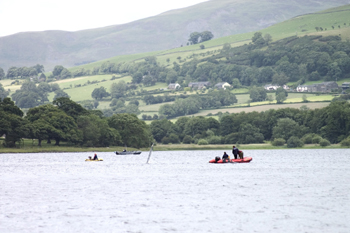Lake Sediment Discovery

Researchers at Lancaster University may have discovered what is behind the unprecedented levels of sediment damaging one of England’s finest lakes.
Bassenthwaite Lake, a 'jewel in the crown' of the English Lake District, and a Site of Special Scientific Interest, is presently subjected to inputs of fine sediment and phosphorus, causing damaging algal blooms and loss of spawning habitat for the rare fish, the vendace.
By driving corers into the lake bed and examining the compacted layers of sediment extracted from beneath the lake floor, researchers have been able to discover how rates of sediment deposition have changed over the last 5,500 years.
Also, by taking a magnetic ‘fingerprint’ of each layer and of each river’s sediment inputs, they have been able to track the source of the sediment which currently appears to be largely coming from just one beck.
Professor Barbara Maher of Lancaster University’s Environment Centre said: “The sediment at the bottom of the lake is a natural archive - as we look back at the layers, it is like flicking through time in the pages of a history book.
“Our record shows that sediment input into the lake has increased rapidly over the last 150 years to reach an unprecedented level. At the present day, these rates of sediment input are at least three times higher than at any time in the last 5,500 years.
“These episodes appear to be in response to specific human activities within the catchment. We can pinpoint the source of the sediment as Newlands Beck, which, despite supplying only ten per cent of the water reaching Bassenthwaite, is supplying 90 per cent of the sediment.
“It is the increasingly intensive land use - especially deforestation and mining activities- and reduction of sediment storage through riverbank straighteningon a key inflow, Newlands Beck, which have resulted in threefold increases in lake sediment input in the last century.”
Also, within the last 10 years, increased winter rainfall and storminess caused by global warming may have had an impact on the rising sediment levels in the lake.
Researchers believe the new data will be critical for effective targeting of mitigation measures in the catchment by the Environment Agency and landowners. Their findings are also likely to be significant for other upland temperate areas, affected not only by increasing land use pressures but also, increasingly, by climate change.